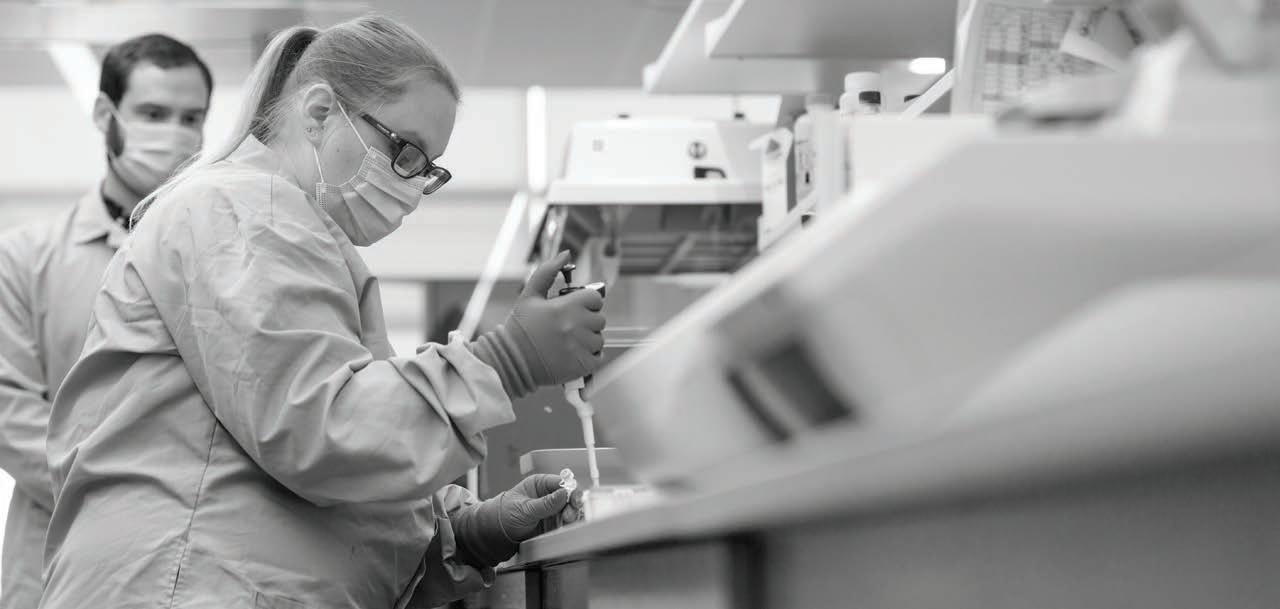
9 minute read
Where Passion Meets Purpose
from Genetics and Genomics Nationwide Children's at the Forefront - Everything Matters in Patient Care
Lee Ann Wallace MBA, BSN, RN, NEA-BC
Senior Vice President, Patient Care Services, Chief Nursing Officer As part of the 2017-2022 Strategic Plan, Nationwide Children's Hospital committed to Best Outcomes for all children. This commitment includes developing cures for rare diseases and a better understanding of the treatment of genetic conditions in children.
Advertisement
Genomics is one of the areas of focus that we believe will accelerate our Journey to Best Outcomes. At the Abigail Wexner Research Institute at Nationwide Children’s Hospital, our world-renowned research teams are breaking new ground in genomics, gene therapy, and tissue engineering. This research will provide transformational work in understanding the genetic causes of disease, an ability to more rapidly sequence genomes, as well as reducing the cost of this state-ofthe-art medical science and technology.
Rather than a one size fits all approach, individualized treatment care plans can be developed using high precision diagnostics. Large research studies are taking place on the identification of cancer tumor DNA while understanding what processes cause a normal cell to become a cancer cell. Developing a better understanding of the cancer location and causes of these over-expressed genes, we will increase our successful outcomes for cancer therapies. The ability to translate their research into treatment using whole-exome sequencing allowing for diagnosis of pediatric conditions that traditional tests and investigation would not be able to identify. Through genome sequencing, targeted therapies, and medications based on the identification of genetic errors will be developed, all leading to improved outcomes.
While work has been focused on rare genetic conditions and cancer, the future is wide open. Other areas of future expansion include diagnosis and treatment of seizure disorders and the ability for rapid identification of neonatal conditions. As care team providers, we need to continue to expand our knowledge and understanding of genomics in our own areas of practice, while identifying the impact of these discoveries on our patients and their families.
2017-2022 JOURNEY TO BEST OUTCOMES
One Team Values
Growth & Partnerships
CORE STRATEGIES
Education Operational Excellence
GOAL
Pre-eminent Clinical & Research Programs
ACCELERATORS
Quality, Safety & Service Behavioral Health Genomics Wellness/ Population Health
VISION BEST OUTCOMES
for Kids Everywhere
Richard K. Wilson, PhD, Executive Director, The Steve and Cindy Rasmussen Institute for Genomic Medicine, The Abigail Wexner Research Institute at Nationwide Children’s Hospital Elaine R. Mardis, PhD, Co-executive Director, The Steve and Cindy Rasmussen Institute for Genomic Medicine, The Abigail Wexner Research Institute at Nationwide Children’s Hospital

When Nationwide Children’s Hospital leadership completed their strategic planning process in 2013, they identified genomics as an accelerator for the hospital that would differentiate its health care in significant and impactful ways as compared to other children’s hospitals. What is genomics and why was it considered a critical accelerator? How did this aim of the strategic plan manifest itself and what has happened since then?
Genomics can be simply defined as the study of the genome, which is the instruction set encoded by the DNA inside of our cells and inherited from our parents. This DNA-based instruction set is interpreted during development as a carefully orchestrated process that builds cells, organs and ultimately an entire human body. Changes to the DNA code of an individual can result in disruptions of this process, resulting in altered development and human disease. The ability to rapidly discover and interpret these changes in individual patients across a variety of pediatric diseases has been accelerated in recent years by several factors.
First and foremost, complete sequencing of the first human genome (the Human Genome Project, 19902003) provided us with the fundamental instruction set in our DNA - namely the location and structure of the protein-coding genes that are shared by all members of the human population. Second, the advent of rapid and relatively inexpensive DNA sequencing technology, combined with advanced computational analysis has enabled genome sequencing to become a high-resolution form of diagnostic laboratory testing. Third, a series of “big science” efforts that catalyzed the study of thousands of individual human genome sequences and permitted the association of DNA-based changes within those genomes with many conditions including cancer, cardiovascular disease, autism and other behavioral disorders, epilepsy, craniofacial, cardiac, and other birth defects and various syndromic metabolic and developmental diseases.
Building upon these critical factors, the inclusion of genome-based diagnostics now enables comprehensive molecular testing for individual patients with complex and otherwise undiagnosed disease by evaluating the entire genome in an unbiased fashion to identify causative changes. This approach is in stark contrast to the single gene testing performed at most children’s hospitals which often results in a very long diagnostic odyssey for the patients and their families.
Recognizing this potential of genomics to improve our understanding, diagnosis and treatment of childhood diseases, Nationwide Children’s established the Steve and Cindy Rasmussen Institute for Genomic Medicine in 2016. The Institute represents a very unique fusion of capabilities including advanced genomics-centered research and development, clinical molecular diagnostic testing and high-performance analytical computing. The intersection of these capabilities enables our mission of interdisciplinary and collaborative research across multiple service lines with a goal of including genomics-based evidence as a critical component of medical practice. Achieving this mission has become manifest in a series of clinical translational protocols, each of which studies patients across a number of childhood disease phenotypes. For example, children who are diagnosed with a brain or other CNS tumor undergo comprehensive analysis of the genome in their cancer cells, in collaboration with our colleagues from Neuro-oncology, Neurosurgery, Pathology, Radiology and Radiation Oncology who directly care for these patients. The results of our analyses are discussed during a weekly tumor board attended by care providers from all of these specialties, with an aim to identify genomic features that may indicate new treatments or predict outcome. The same protocol has evaluated patients with sarcomas, with blood cancers of various types and more recently, with overgrowth syndromes that often are caused by mutations in cancer-related genes. In total, more than 230 patients have been studied on this protocol since January 2018 and over 93% of those studied had one or more medically meaningful results identified by our analyses.
Similarly, children with treatment-refractory epilepsy without a known inheritance pattern often undergo brain activity mapping and surgery to remove affected tissues and thereby eliminate or reduce the intensity and frequency of their seizures. Working with our colleagues in Neurosurgery, Neurology and Pathology, we have studied the genome from tissue removed at surgery to identify and characterize genomic changes associated with the cause of their disease. Many of these changes are unique to the affected

tissue and may reflect changes that emerged not from inheritance but instead from DNA copying errors during normal development and growth in utero. This protocol has evaluated over 40 patients to-date, with a return of medically relevant information in 35% of the patients studied. In most cases, this information will not impact patient care, but there is an intangible value in parents being able to understand the underlying cause of their child’s seizures.
In collaboration with Nationwide Children’s medical genetics providers, we annually study more than 300 children with undiagnosed syndromic or complex disorders thought to have underlying genetic causes. This test, which can be ordered through our clinical laboratory, evaluates the patient’s protein coding genes in comparison to those of both parents, when possible, to identify changes unique to the child’s genes that may provide clues to the disorder or help identify the syndrome. A clear determination of genetic cause is identified for around 33% of patients evaluated by this clinical test. In the event of a negative result, we may offer these families the option of enrollment onto our rare disease genomics protocol, which performs sequencing of the complete genomes of the patient and parents, and in some cases includes individuals from the family pedigree that are also affected. Using this comprehensive approach, we have uncovered complex changes to the DNA of affected individuals that explains their disorder or syndromic difficulties yet could not have been identified by the clinical test which only evaluates about 1.5% of the genome.
Our successes in the rare disease genomics protocol have led to a new effort that also focuses on whole genome sequencing of child and parents, but in this

case involves tiny newborns in our neonatal intensive care unit with a variety of failure-to-thrive related difficulties, including metabolic and developmental problems. The big difference in this procedure is our goal to return information about these babies to our neonatal ICU providers in only 48 hours! This time-to-results goal is a technical and logistical challenge that we are still tackling, yet we have already made significant progress, having returned information on our most recent case in only 4 days.
Two other areas of collaborative study have emerged in the past year. One area focuses on the relationship between our health and our microbiome, which is defined as the bacteria and viruses that naturally live in and on our bodies. Research has illustrated that this close relationship between humans and microbes shapes our illness and health in ways that had not previously been appreciated and has sparked further study in the pediatric realm. These studies include gaining a better understanding of the impact of vaccines and antibiotics on the normal gastrointestinal flora, adverse effects on normal flora caused by anti-anxiety medications and how microbes impact childhood neuronal development. Most recently we have opened a collaborative protocol with researchers and care providers in a new focus area at Nationwide Children’s Behavioral Health. Here we will use the body of knowledge emerging from psychiatric genomics and autism genomics research to study pediatric patients and their families who have been diagnosed with autism, with depression leading to suicidality and with bipolar disorder. Longterm we anticipate our work in behavioral genomics will transition to the setting of genomic testing as a component of medical diagnosis for these children.
While strong progress has been made toward our mission at the Rasmussen Institute, it is clear that additional medical service lines will benefit from the integration of genomics into both research and clinical practice. To better identify and define these opportunities, a critical activity involves education of clinical providers regarding the application of genomics - what it can and cannot address. Similarly, we benefit from understanding the challenges and unanswered questions in these different areas of pediatric medical practice and using this information to shape study design, patient accrual and other important aspects that maximize the yield of information we obtain. With a basic understanding of each other’s vocabulary, strengths and challenges, we can better define the way by which genomics can help answer the difficult questions that clinicians must address when diagnosing and treating their patients. This is the essence of team science in precision medicine and why genomics is an accelerator for our hospital and its important focus on providing the best care possible for our patients.







